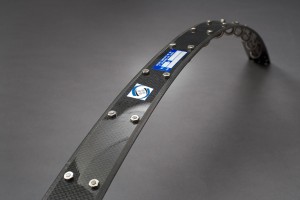Failures – Identifying the Root Cause
 Bow failures are almost always due to external factors. Reasons may include:
Bow failures are almost always due to external factors. Reasons may include:
- Wire breaks.
- Improper balancing after attaching the retaining hardware and wear strip.
- Foreign objects accidently left inside the machine picked during winding can break the bow on contact.
- Fluctuating wire tension either upon entry or exit, causing the bow to flex in or bow out, and hit a stationary machine part.
- Quick start-up or shutdown of the machine can cause the bow to twist and break.
- A change in the product being processed may require a change in bow.
- Clamps in some machines can slip out of alignment, which can cause undue stress.
- Centrifugal force may carry the bow out. If the outer edge of the clamp is sharp, it may cause bow failure at the clamp.
- Insufficient preventive machine maintenance (bearing wear, vibrations, etc.) may contribute to bow failure.
- Human error relating to inexperience with machine operation.
Failures can also result from the use of substandard materials, poor design, incorrect material selection, and inferior manufacturing methods.
The following 2 lists related to the bow and the machine should help you increase bow life and overall productivity.
5 Bow ‘C’s
- Correct profile
- Correct composite (i.e,, uni/bi/triaxial carbon fiber; fiber glass; or GKC)
- Correct size
- Correct hardware
- Correct fit
5 Machine ‘P’s
- Proper preventive maintenance with check sheets to verify
- Properly trained operators with up-to-date standardized work
- Properly certified suppliers providing built-in quality
- Proper equipment set-up based on the control plan with check sheets to verify
- Proper 5S* environment with equipment, tools & inventory management
*A workplace organization method based on a list of five Japanese words, which describe a process for creating and maintaining new order. There are 5 primary phases that can be translated into 5 English ‘S’ words – sorting, straightening, systematic cleaning, standardizing, and sustaining. Sometimes, the process includes 3 other phases – safety, security, and satisfaction.



